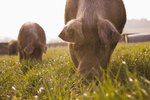Things You'll Need
Litter box
Cat litter
Water and food dishes
Child or doggy gate
Blanket
Shed or dog house
Fencing
Pig feed pellets
Potbellied pig treats
Warnings
Pigs and dogs don't mix. There are many reports of mini pigs being attacked and killed by dogs each year. If you have a dog, don't add a pig to the mix.
Obesity is a problem for pigs and all the proper nutrition they require is in special pig feed. Feeding table scraps and too many treats will spoil the pig and lead to poor health.
Don’t limit the amount of food you feed the animal to keep the pig’s size down. Some people try to stunt the growth of piglets by reducing the recommended amount of food, which only leads to an unhealthy and unhappy animal.
Micro mini or miniature Juliana pigs are very intelligent, social animals and are often kept as pets. Micro minis grow to be about 25-50 pounds and 10-16 inches tall at the shoulder; some breeders claim to raise pigs that will be even smaller as adults. They live between 15 and 20 years. You need to piggy-proof your house for these friendly and curious critters, but they can be easily housebroken and trained as house pets. The basic care and feeding for micro minis is the same as that for larger miniature potbelly pigs.
Create a controlled environment for your piglet. Use a child or doggy gate to block the doorway to a laundry room or bathroom to use as a pig area. Place a blanket in a corner for bedding. Put a litter box with cat litter in the area. Pigs can quickly learn to use the box. Provide water and food dishes; flat pie pans are best for food. Make sure the area you choose is draft-free for baby piglets.
Piggy proof your house. Pigs are curious and intelligent and will get into anything within their reach. Pick up magazines and papers, secure cabinets with child-proof locks, remove breakable objects from low tables and secure electrical cords where pigs can’t get at them to chew.
Make a safe outdoor area for your pig as it grows. Pigs need to be exposed to sunlight and fresh air. Fence around an insulated shed or dog house to create a safe enclosure for the pig. Plant chicken wire 6 inches into the ground under the fence so the pig can’t dig out. Pigs don’t sweat, so they need shade and a cool place to get out of the sun. Place a child’s wadding pool or mud hole in the enclosure in the summer for the pig to use to cool off.
Feed your pig special miniature pig feed. Food developed especially for miniature pigs is available from Purina, Mazuri, Heartland, Peak Performance, Nutrina and Manna Pro. Pigs will eat anything, but they are prone to obesity when fed the wrong food. Special pig chow will ensure your pet gets the proper nutrition and doesn’t gain unnecessary weight, which can be a health concern. Pigs should generally be fed 1/2 cup of pig feed for every 25 pounds of body weight, divided into half and given in two separate meals. Growing baby pigs can be free fed and usually consume 1-1 1/2 cups of feed a day; some extremely small pigs eat less.
Supplement the pig’s diet with a small salad of fresh vegetables daily. Fresh fruit should be offered in limited amounts due to the high calories.
Use potbellied pig treats as training aids. Limit the amount of treats. Pigs that are overindulged can become beggars and aggressive when not able to get goodies.
References
Resources
Warnings
- Pigs and dogs don't mix. There are many reports of mini pigs being attacked and killed by dogs each year. If you have a dog, don't add a pig to the mix.
- Obesity is a problem for pigs and all the proper nutrition they require is in special pig feed. Feeding table scraps and too many treats will spoil the pig and lead to poor health.
- Don't limit the amount of food you feed the animal to keep the pig's size down. Some people try to stunt the growth of piglets by reducing the recommended amount of food, which only leads to an unhealthy and unhappy animal.
Photo Credits
-
Keystone/Valueline/Getty Images



